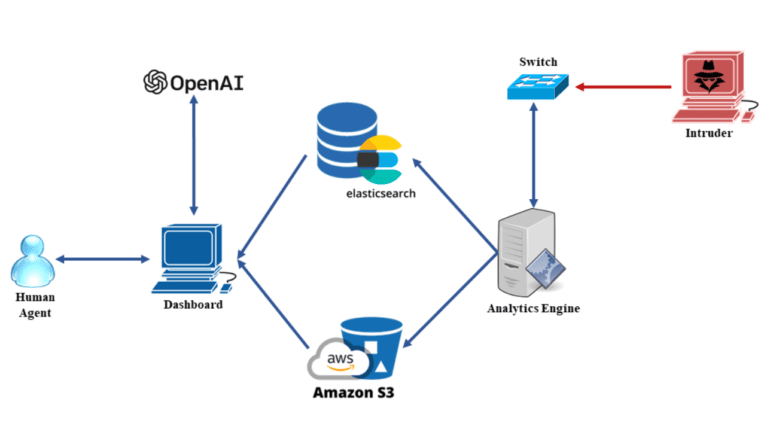TL;DR:
- Critical infrastructure faces escalating cyberattacks, projected to cause $10.5 trillion USD in damages by 2025, up from $3 trillion USD in 2015.
- NIST’s 2014 Cybersecurity Framework addresses evolving threats.
- Machine learning-based anomaly detection tools identify known and unknown threats but raise false positives in practice.
- Large Language Models (LLMs) like HuntGPT revolutionize cybersecurity by integrating AI, reducing operational costs, and enhancing threat response.
- HuntGPT, an AI-based intrusion detection tool, leverages LLMs and Explainable AI (XAI) frameworks for user-friendliness.
- SMEs struggle with cybersecurity due to budget constraints; HuntGPT offers an affordable solution.
- LLMs like ChatGPT have potential in cyber hunting interfaces, making cybersecurity insights accessible to non-experts.
- The Anomaly Detection Application Server integrates various sub-modules for network anomaly detection.
- The IDS Dashboard combines visualizations, AI explanations, and interactive features for informed decision-making.
- HuntGPT achieved a 72% to 82.5% success rate on certification exams, highlighting its effectiveness.
Main AI News:
The landscape of critical infrastructure is under constant siege from cyberattacks, and the projected annual damages are set to reach a staggering $10.5 trillion USD by 2025, soaring from a mere $3 trillion USD in 2015. In response to this escalating threat, the National Institute of Standards and Technology (NIST) introduced the Cybersecurity Framework in 2014, a pivotal step in countering evolving cyber dangers.
Harnessing the power of machine learning, anomaly detection tools have emerged as crucial players in identifying both known and previously unidentified threats, spanning performance and security anomalies. Yet, the practical application of these tools often introduces a challenging dilemma, as they tend to yield an increased number of false positives in real-world scenarios.
Enter Large Language Models (LLMs), poised to revolutionize the realm of cybersecurity. LLMs seamlessly integrate AI capabilities, offering a path to streamline operations and cut down on costs. Their unique adaptability and pivotal role in actionable AI render them indispensable in the quest for robust threat response strategies.
In a recent report, cybersecurity experts Tarek Ali and Panos Kostakos, affiliated with the Information Technology and Electrical Engineering Center for Ubiquitous Computing at the University of Oulu, shed light on HuntGPT, a cutting-edge AI-driven intrusion detection tool.
HuntGPT is not your ordinary cybersecurity tool. This sophisticated platform boasts a dashboard equipped with a Random Forest classifier, honed through rigorous training on the KDD99 dataset. To further enhance user-friendliness and comprehension, HuntGPT leverages Explainable AI (XAI) frameworks like SHAP and Lime. But the real game-changer here is GPT-3.5 Turbo, which presents detected threats in a format that’s not just informative but also easily comprehensible.
The Challenge of Cybersecurity for SMEs
Small and medium-sized enterprises (SMEs) often find themselves grappling with cybersecurity woes. The primary culprits behind these struggles include budget constraints, staffing shortages, and the ever-present limitation of time. A stark reality emerges when we consider that a medium-sized Security Operations Center (SOC) team demands a substantial budget of $1,635,000. Clearly, there is an urgent need for affordable and effective cybersecurity solutions tailored to the unique challenges faced by SMEs.
These remarkable AI-driven models operate as standalone tools, significantly aiding in policy formulation and log parsing with unparalleled accuracy. Furthermore, there exists untapped potential for LLMs like ChatGPT to elevate the field of cyber hunting interfaces, providing invaluable insights to individuals without specialized cybersecurity backgrounds, much akin to the knowledge transfer witnessed in the financial sector.
The Anomaly Detection Application Server: An Overview
At the heart of this innovation is the Anomaly Detection Application Server, orchestrating the complex network anomaly detection process through a meticulously integrated suite of sub-modules. The core components of this server include the ML Model Loader, Elasticsearch Connector, Prediction Engine, Explainer Module, Elasticsearch, and AWS S3 Bucket.
Empowering Users with the IDS Dashboard
The IDS (Intrusion Detection System) Dashboard is where the magic truly unfolds. This powerful tool combines intuitive visualizations, AI-generated explanations, and interactive dialogues, all aimed at assisting users in making well-informed decisions regarding network anomalies. It excels in various scenarios, including threat identification, incident classification, and model interpretability.
A Triumph of Innovation:
The HuntGPT Study In a groundbreaking study, the effectiveness of HuntGPT shines through as a prototype that seamlessly integrates LLM-based conversational agents with XAI in intrusion detection systems. Remarkably, HuntGPT achieved stellar results, boasting success rates ranging from 72% to an impressive 82.5% on certification exams. These results not only affirm its prowess but also pinpoint areas for further refinement in fundamental cybersecurity concepts.
Conclusion:
HuntGPT represents a pivotal advancement in cybersecurity, offering a powerful solution to combat the escalating threat landscape. Its seamless integration of AI, cost-effectiveness, and user-friendliness positions it as a game-changer in safeguarding critical infrastructure and digital ecosystems. As cyber threats continue to evolve, HuntGPT’s impact on the market is poised to be transformative, driving the adoption of AI-driven cybersecurity solutions across various industries and sectors.

